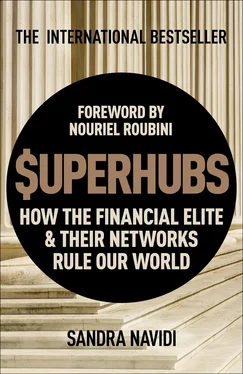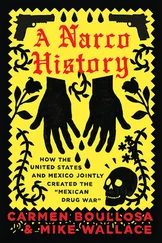Sandra Navidi - SuperHubs - How the Financial Elite and Their Networks Rule our World
Здесь есть возможность читать онлайн «Sandra Navidi - SuperHubs - How the Financial Elite and Their Networks Rule our World» весь текст электронной книги совершенно бесплатно (целиком полную версию без сокращений). В некоторых случаях можно слушать аудио, скачать через торрент в формате fb2 и присутствует краткое содержание. Год выпуска: 2017, Издательство: Hodder & Stoughton, Жанр: Старинная литература, на английском языке. Описание произведения, (предисловие) а так же отзывы посетителей доступны на портале библиотеки ЛибКат.
- Название:SuperHubs: How the Financial Elite and Their Networks Rule our World
- Автор:
- Издательство:Hodder & Stoughton
- Жанр:
- Год:2017
- ISBN:нет данных
- Рейтинг книги:4 / 5. Голосов: 1
-
Избранное:Добавить в избранное
- Отзывы:
-
Ваша оценка:
- 80
- 1
- 2
- 3
- 4
- 5
SuperHubs: How the Financial Elite and Their Networks Rule our World: краткое содержание, описание и аннотация
Предлагаем к чтению аннотацию, описание, краткое содержание или предисловие (зависит от того, что написал сам автор книги «SuperHubs: How the Financial Elite and Their Networks Rule our World»). Если вы не нашли необходимую информацию о книге — напишите в комментариях, мы постараемся отыскать её.
SuperHubs: How the Financial Elite and Their Networks Rule our World — читать онлайн бесплатно полную книгу (весь текст) целиком
Ниже представлен текст книги, разбитый по страницам. Система сохранения места последней прочитанной страницы, позволяет с удобством читать онлайн бесплатно книгу «SuperHubs: How the Financial Elite and Their Networks Rule our World», без необходимости каждый раз заново искать на чём Вы остановились. Поставьте закладку, и сможете в любой момент перейти на страницу, на которой закончили чтение.
Интервал:
Закладка:
THE NEXT CRISIS: SYSTEMIC FAILURE AND CONTAGION
Most experts agree that a new crisis is just a matter of time. The IMF has warned of a new financial crisis that could overwhelm the world’s defenses.23 Claudio Borio of the Bank for International Settlements suggests that we may be seeing the “signs of the gathering storm that has been building for a long time” and that central banks, which have kept the global financial system on life support, are running out of options.24Andrew Haldane, chief economist of the Bank of England, believes that recent events could form the latest leg of what he calls a three-part crisis trilogy,25 and the former governor of the Bank of England, Mervyn King, writes in his book The End of Alchemy that without reforms another financial crisis “will come sooner rather than later.”26 Countless other economists all over the world, including Sheila Bair, former head of the FDIC, view the current system to be unstable.27 In her opinion, “people need to understand that we are at risk of another financial crisis unless the general public more actively engages in countering the undue influence of the financial services lobby.”28
The Culprit: The Superhubs or the System?
Systemic stability has mostly been analyzed on the basis of institutional interconnections rather than at the level of individuals. Yet it is human beings, not abstract entities, who make decisions on the institution’s behalf and ultimately impact the system. However, in contrast to institutions, whose transactions and capital flows can be quantitatively calculated, human relationships are much harder to categorize, measure, and stress-test. Superhubs have a quasi-monopoly on top-level, globalized relationships, which provides them with enormous network power. The resulting hyperconnectivity—especially in its combination with capital acting as an amplifier—poses a risk to the public good of systemic stability.
One of the key questions to consider is whether the superhubs are to blame for the fragile state of our financial and economic system. Has the crisis been a failure of individuals, or the system itself? Have they held the system prisoner, or are they themselves prisoners of the system?
Many experts, like former governor of the Bank of England Mervyn King, believe that blaming individuals is no substitute for acknowledging the failure of a system.29 It would be counterproductive to assume that if all the lever-pullers were punished, we would never experience a crisis again. Rather, he argues, “the crisis was a failure of the system, and the ideas that underpinned it, not of individual policymakers or bank-ers.”30 Similarly, Adair Turner, former head of the U.K. financial regulatory authority FSA, says that “if we think the crisis occurred because of individual ‘bad apples’ who corrupted the system . . . we will fail to make adequately radical reforms.”31 In the same vein, William Dudley, president of the Federal Reserve Bank of New York, thinks the focus should be less on searching for bad apples and more on improving the apple barrels.32
Yet, the picture may not be so clear-cut. As we’ve seen in Chapter 1, individual superhubs are neither in charge of, nor do they have control over the system, because finance is a complex self-organizing system, where the actions of autonomous individuals lead to collective activity. Although there is no “central command” directing events, the large-scale effects of all the individual players’ independent actions determine the overall behavior of the system. Therefore, it is the interaction between both the system and the individuals that determines developments.
Disequilibrium: Superhubs Preventing the System from Correcting Itself
Interconnectedness is to some extent an inherent component of the financial system and indispensable for the exchange of goods and services. In order to optimally scale and capitalize on the system, top executives tend to build ever more interlinkages, thus making the system increasingly more complex. Up to a certain point, a high number of links tends to make the system more stable, because it creates greater balance between individual nodes and—specifically in finance—facilitates risk sharing.
However, too many connections are destabilizing because they enable failure to cascade through the system. In contrast, if a system has more nodes with fewer connections, the domino effect cannot spread much further than those affected nodes.33 Lehman Brothers illustrated how the failure of one node can unexpectedly multiply and travel through the system with unprecedented speed. Man-made systems are generally more fragile than natural ones, and when complexity coincides with homogeneity, these system becomes robust yet paradoxically fragile, so when a crisis event strikes, superhubs become superspreaders of risk and disruption.34
Why does our system’s default mode seem to be destined for failure? Because in every system—be it the ecology, epidemiology, or physics—network dynamics eventually lead to greater levels of homogeneity, interconnectedness, and complexity.35 Generally, systems are adaptive and self-correcting; when they become too lopsided, autocorrecting feedback mechanisms kick in and stabilize the system. Systems with unchecked reinforcing loops, however, ultimately destroy themselves.36 Through feedback loops and power-laws, superhubs and their networks have significantly contributed to skewing the system. Potentially corrective shocks like the financial crisis have failed to rebalance it because the overly influential superhub networks have blocked fundamental changes to protect their vested interests.
An example of this is the persistence of systemically important “too big to fail” banks, which still present a risk to taxpayers. Wall Street CEOs have put up a fabulous fight against measures threatening the size of their institutions, and, thus, their financial interests. Even Neel Kashkari, who as assistant secretary of the treasury was instrumental in orchestrating the bank bailouts, is now spearheading efforts to decrease the size of banks to minimize the risks for taxpayers.37
“Executive Contagion”: Executives Becoming Super-Spreaders of Risk
The formation of hubs and superhubs follows the laws of nature, so that the same type of network topology will always form, be it among tradespeople in a city, students at a university, or movie stars on the global stage. Due to human beings’ proclivity to surround themselves with people who are like them, top executives have similar mind-sets, influence and emulate one another, obtain the same information, and make like-minded decisions. Accordingly, their views, business models, and risk appetites closely resemble one another.38
The tendency to act in concert leads to “executive contagion” when collective behavior at the highest level spreads through the system and destabilizes it. The term “contagion” is derived from epidemiology and means transmission by contact. In finance, such contagion can be triggered by panics such as bank runs, in which so many savers concurrently withdraw their deposits that institutions become illiquid and eventually insolvent, as in Jimmy Stewart’s It’s a Wonderful Life. By the same token, loss of faith and panic can spread among executives as well. Such executive contagion starts at the top, spreads laterally, and cascades down the system—often with grave consequences. Executives govern powerful institutions, direct billions of dollars, and institute impactful policies. If one executive suffers a shock, his reaction can influence other executives to think, feel, and act in the same way, be it for perfectly rational reasons or unfounded assumptions. As a result of contagion, their individual actions multiply and create a domino effect that ripples through the system.
Читать дальшеИнтервал:
Закладка:
Похожие книги на «SuperHubs: How the Financial Elite and Their Networks Rule our World»
Представляем Вашему вниманию похожие книги на «SuperHubs: How the Financial Elite and Their Networks Rule our World» списком для выбора. Мы отобрали схожую по названию и смыслу литературу в надежде предоставить читателям больше вариантов отыскать новые, интересные, ещё непрочитанные произведения.
Обсуждение, отзывы о книге «SuperHubs: How the Financial Elite and Their Networks Rule our World» и просто собственные мнения читателей. Оставьте ваши комментарии, напишите, что Вы думаете о произведении, его смысле или главных героях. Укажите что конкретно понравилось, а что нет, и почему Вы так считаете.












